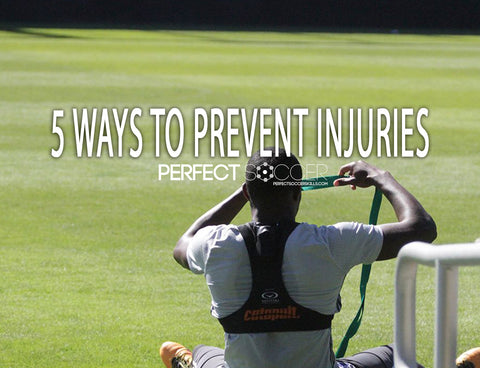5 Ways to Prevent Injuries
 Soccer is an intense, non-stop sport, so it’s not surprising that tens of thousands of soccer-related injuries happen every year.
Soccer is an intense, non-stop sport, so it’s not surprising that tens of thousands of soccer-related injuries happen every year.
While some injuries can’t be avoided, many of them can by simply being aware of what causes them.
Below you will find five great ways to reduce your chances of suffering an injury on the soccer field.
1. Conditioning
Whether you are a few months away from the season beginning or you are currently in the middle of it, you simply have to keep your body in good condition. You can do lot of the conditioning work in practice, but you can’t stop there. You need to find as much time as you can during the week to do solo exercises.
The reason why conditioning is so important is because you greatly increase your chances of getting injured on the field if you tire out quickly. The more cardio and strength training that you do, the more physically and mentally comfortable you will be on the field. Remember that having great strength in soccer is just as much about staying healthy as it is about out-muscling opposing players.
http://www.PerfectSoccerSkills.com/Quiz
2. Stretch
Regular stretching can prevent the most common injuries in soccer. There is always a chance that you can strain your quadriceps during a practice or game, but you greatly reduce those chances if you take stretching seriously.
While it is important to stretch out your entire body before playing soccer, you especially want to focus on your hips and your legs. You use your legs more than anything else in soccer, so you want them to be completely stretched out before you step on the field to play.
3. Water and Sports Drinks

Most soccer players know that they should drink plenty of water to keep themselves healthy, but many don’t know why it’s important. Water and sports drinks are necessary to reduce the chances of dehydration and to keep your energy levels up throughout your practices and games. They also allow you to cool down before, during and after your physical activities.
To keep your body in good condition, drink about three cups of water or a sports drink a few hours before your practice or game. Then you’ll want to drink about a cup just before you start playing. Lastly, either drink another cup every 20 or so minutes during practice, or at halftime during your game. It’s very easy to forget to get that halftime drink, so be sure to make a habit of it.
http://www.PerfectSoccerSkills.com/Quiz
4. Gear
If you are going to play soccer, you should not settle for old, dinged up cleats and shin guards. You don’t have to spend a lot of money on your gear, but make sure that they give you enough protection to get you through a game unscathed. Many of the leg injuries that occur in soccer each year could have been avoided with better gear. Make sure that you get the right cleats for your position and all of your other gear fits properly.
5. In-Game Risk Management
There is nothing wrong with going “all-out” when you are on the soccer field… as long as you do so without risking bodily harm. All of the things listed above will help prevent injuries, but it’s up to you to know when there is potential for instant-impact injuries.
As you gain experience on the soccer field, you will know when it is worth it to go all-out and when you should pull back. For example, if you are running full speed for a header near the goal post, you will eventually have a feel for where the ball is going to land so you know if it’s worth going for or not. Always remember that safety comes first on the soccer field and to only do things that you are comfortable doing.
If you are new to the sport, check out our tips for beginner soccer players before you step on the field for a competitive match. Then you can slowly work your way up to full-speed games.
| More on Perfect Soccer... | ||
 |
 |
 |





Leave a comment